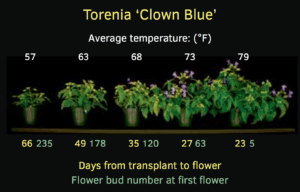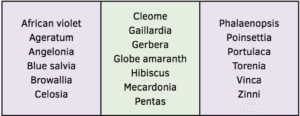Bedding Plants with High Base Temperatures
In the late winter and spring, many greenhouse growers produce a wide variety of species and cultivars, many of which are annual bedding plants. Crops can have different growing and flowering requirements, so plants shouldn’t all be grown the same way. For example, some crops need a more acidic media pH (calibrachoa) while others perform best at a higher pH (geranium); some perform best with little fertilizer (New Guinea impatiens) while others have higher fertility demands (petunia).

When it comes to the growing environment, plants respond differently to photoperiod and temperature. In an ideal production situation, bedding plants would be grown in zones with at least two (and preferably three) different temperature setpoints to simultaneously regulate flowering time while managing plant quality.
In the past decade, we have generated research- based information to quantify how plants grow and develop at different temperatures and characterized flowering time and plant quality attributes. We have classified crops into three temperature response categories based on the estimated base temperature of each species.
The base temperature is the cool temperature at which plants stop growing. Some crops begin to grow at temperatures in the low- to mid-30s, while other crops don’t begin to grow until the low- to mid-50s. Except when trying to vernalize plants (such as for bulbs and perennials), or to “hold” crops when finished plants can’t be shipped, plants should be provided with a temperature so that they actively grow. However, when light is limiting, there’s a need to balance temperature with light quantity. Under a low daily light integral (DLI), crops grown warm can develop quickly but be of poor quality (thin stems, elongated growth, and few flowers).
One of the three temperature response categories is “cold sensitive crops,” which are plants with an estimated base temperature of 46° F or higher. These crops often have tropical or semi-tropical origins and grow very slo
wly at moderately cool temperatures; see some examples in Table 1. When the DLI is low (less than 10 mol∙m–2∙d–1), recommended average daily temperatures for these crops is 68 to 73° F. This is a guideline to balance crop timing with crop quality. When the average DLI exceeds 10 mol∙m–2∙d–1, crops can be grown 5° F warmer to accelerate development while maintaining an acceptable plant quality.

Torenia (wishbone flower) is a good example of a cold-sensitive crop (Figure 1). Plants grow very slowly at cool temperatures, taking nine to 10 weeks to flower at an average temperature of 57° F. A trade-off of the long production time is that those plants have a huge number of flower buds when the first flower opens. As temperature increases, time to flower decreases, but so does flower bud number. A reasonably good trade-off of balancing flowering time and flower number is around 68 to 73° F.
When it’s cold outside, it’s tempting to lower the greenhouse temperature setpoints to reduce heating costs on a daily basis. A consequence is that plants take increasingly longer to flower, especially for cold-sensitive crops. Thus, when possible, grow cold-sensitive crops together at a warmer temperature than other crops — but don’t grow them too warm (for example, above 73° F when light conditions are limiting because crop quality could be marginalized).
Erik Runkle is professor and floriculture extension specialist in the department of horticulture at Michigan State University. He can be reached at runkleer@msu.edu.








 Video Library
Video Library 

















